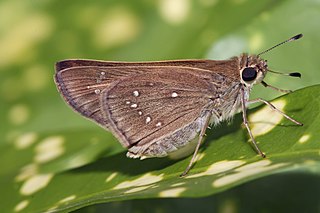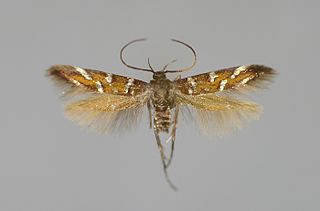
Skippers are a family of the Lepidoptera named the Hesperiidae. Being diurnal, they are generally called butterflies. They were previously placed in a separate superfamily, Hesperioidea; however, the most recent taxonomy places the family in the superfamily Papilionoidea. They are named for their quick, darting flight habits. Most have their antenna tips modified into narrow, hook-like projections. Moreover, skippers mostly have an absence of wing-coupling structure available in most moths. More than 3500 species of skippers are recognized, and they occur worldwide, but with the greatest diversity in the Neotropical regions of Central and South America.
Sir George Francis Hampson, 10th Baronet was an English entomologist.

Nepticulidae is a family of very small moths with a worldwide distribution. They are characterised by eyecaps over the eyes. These pigmy moths or midget moths, as they are commonly known, include the smallest of all living moths, with a wingspan that can be as little as 3 mm in the case of the European pigmy sorrel moth, but more usually 3.5–10 mm. The wings of adult moths are narrow and lanceolate, sometimes with metallic markings, and with the venation very simplified compared to most other moths.

Urodidae or "false burnet moths" is a family of moths in the lepidopteran order, representing its own superfamily, Urodoidea, with three genera, one of which, Wockia, occurs in Europe.

Copromorphoidea, the "fruitworm moths", is a superfamily of insects in the lepidopteran order. These moths are small to medium-sized and are broad-winged bearing some resemblance to the superfamilies Tortricoidea and Immoidea. The antennae are often "pectinate" especially in males, and many species of these well camouflaged moths bear raised tufts of scales on the wings and a specialised fringe of scales at the base of the hindwing sometimes in females only; there are a number of other structural characteristics. The position of this superfamily is not certain, but it has been placed in the natural group of "Apoditrysia" "Obtectomera", rather than with the superfamilies Alucitoidea or Epermenioidea within which it has sometimes previously been placed, on the grounds that shared larval and pupal characteristics of these groups have probably evolved independently. It has been suggested that the division into two families should be abandoned.
Heliodinidae, commonly known as sun moths, is a family of small moths with slender bodies and narrow wings. Members of this family are found in all parts of the world.
Agathiphaga is a genus of moths in the family Agathiphagidae, known as kauri moths. This caddisfly-like lineage of primitive moths was first reported by Lionel Jack Dumbleton in 1952, as a new genus of Micropterigidae.

The Thyatirinae, or false owlet moths, are a subfamily of the moth family Drepanidae with about 200 species described. Until recently, most classifications treated this group as a separate family called Thyatiridae.

Pancalia is a genus of moths in the family Cosmopterigidae.

Euclemensia woodiella, the Manchester tinea, is a yellow and brown British moth. It is regarded as extinct, and is known from only three museum specimens, one of which is held by the Manchester Museum, one by the Natural History Museum, London, and the type, which is in the Curtis Collection at Museum Victoria.
Pancalia baldizzonella is a moth in the family Cosmopterigidae. It is found in Italy.

Pancalia leuwenhoekella is a moth in the family Cosmopterigidae. It is found in nearly all of Europe. In the east, the range extends to Asia Minor, the Caucasus, south-western Siberia and the Russian Far East.
Pancalia hexachrysa is a moth of the family Cosmopterigidae. It was described by Edward Meyrick in 1935. It is found in Japan and Russia.
Pancalia amurella is a moth in the family Cosmopterigidae. It was described by Reinhard Gaedike in 1967. It is found in the Russian Far East and China.
Pancalia aureatus is a moth in the family Cosmopterigidae. It was described by C.K. Yang in 1977. It is found in Beijing, China.
Pancalia sinense is a moth in the family Cosmopterigidae. It was described by Reinhard Gaedike in 1967. It is found in China.
Pancalia swetlanae is a Russian moth in the family Cosmopterigidae. It was first described by Sinev in 1985.
Pancalia wuyiensis is a moth in the family Cosmopterigidae. It was described by Z.W. Zhang and H.H. Li in 2009. It is found in China (Fujian).
Pancalia pyrophracta is a moth in the family Cosmopterigidae. It was described by Edward Meyrick in 1923. It is found in the Assam, India.
Ressia didesmococcusphaga is a moth in the family Cosmopterigidae. It is found in China.







